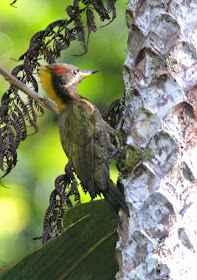Today weekend was just a cursory visit to bring NK Wong a novice bird photog to Kemensah. He was using 5D mark III and Sigma 150-500mm. Hand held some more without tripod. I pretty sure with the low light in the shade; he would find it hard to get good sharp photos. As I suspected he call it quits soon enough and just followed me without even bothered to shoot the many birds that I pointed to him Dead tired hand carrying the camera or the slow speed shooting my guess. The mosquito harassment was horrendous too and a distraction to NK. I am sure the encounter will be a good lesson for him and it will not deter him. Hope he will take my advise to invest in a tripod and Wimberley head. He can contact JT 016-2985801 for the latter.
Kemensah is happening place in the month of May- June. Plenty of fruiting trees. Regret that I did not come-out to bird earlier in the months of April & May and only after request from people to my blog asking me to bring them to see birds. Well birding do bring new acquaintance and that is a good thing ..........

As expected we saw a lot post nesting activity including that of the Blue-eared Kingfisher and Little Spiderhunter. NK spotted a Lemur clinging tightly to the tree trunk and was still there when we were leaving ISIRIMBA at 11am. Yes the resident Lesser Fish Eagle pair were heard in the canopy but somehow we cannot spot them for the entire morning.
The highlight for today is the Green Broadbill which I think is a juvenile. It was fluttering its wings when ever it see birds approaching. We did not see its parent though. The Black&Yellow was also seen but kept to the higher storey for any good picture.

On the way out at about saw the lovely Ruby-cheeked Sunbird at a distance of 25ft away. It had its beak open to cool down I do not know. Plenty of fruiting tree bring congregations of bulbuls and leafbirds.
Earlier in the wee morning I got to shot Zoo Negara free range White Pelican which was hanging with the many milky storks on MRR2.


The crested and black headed Bulbuls were amongst the red-eyed Bulbuls feast on the berries at Kemensah.




































